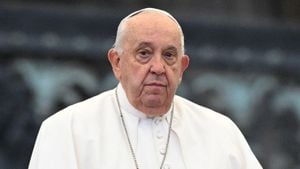Financial assistance to Ukraine from the United States has reached significant figures amid its continuing struggle against Russian aggression. According to official statements, the U.S. has provided around $67 billion worth of military equipment and about $31.5 billion directly to support Ukraine's budget over various programs.
The support from the U.S. has been deemed as pivotal by Ukrainian leaders. President Volodymyr Zelensky underscored this support during various addresses, emphasizing the necessity of U.S. aid to bolster defenses and sustain the country's economy during tumultuous times. He pointed out the overwhelming nature of military support as not just about weapons but also related to more extensive financial backing.
Nevertheless, recent discussions led by U.S. House Speaker Mike Johnson indicate waning enthusiasm among lawmakers for new funding initiatives directed at Ukraine. Johnson noted, "there is little appetite" for additional legislation aimed at financing the war effort, raising questions about future commitments from the U.S. as the situation develops.
This reluctance may stem from broader political sentiments within the U.S., where there are increasing debates about domestic priorities versus international obligations. Some lawmakers are advocating for realigning spending to address internal concerns, positing risks of diminishing support for Ukraine could have lasting effects on its war efforts.
Historically, military and economic aid from the U.S. has been structured to bolster security and enable allies to stand against perceived threats—an effort exemplified by earlier funding measures. Recent aid categories also included substantial allocations for security, with nearly $870 million designated for initiatives concerning Taiwan, and over $21.5 million funneled toward equipment like body armor and armored vehicles for the Ukrainian police and border forces.
Yet, the humanitarian aspect of funding remains relatively under-discussed. Reports indicate minimal exemptions for humanitarian aid, with less than $100 million allocated through exception programs for USAID, contrasting starkly with approximately $40 billion typically designated for similar assistance annually before recent funding freezes.
Notably, the financial assistance provided to Ukraine must be weighed against the geopolitical backdrop of global security. The U.S. maintains its support not merely for the humanitarian crisis but with strategic interests intertwined with European stability and democratic governance. The international community's response and the U.S.'s role reveal much about their commitment to these principles.
While Congress deliberates on future funding trajectories, both sides of the aisle express concerns about the course of the Ukraine conflict, stressing the need for clear communication and solidarity from the U.S. government. Some lawmakers argue against portraying Ukraine as merely passive recipients of aid, instead advocating for supportive partnerships based on shared democratic values and regional stability.
The eventual legislative focus on how much financial aid the U.S. can provide without compromising domestic agendas will continue to be central to the discourse surrounding Ukraine. Observers note the necessity for articulations of policy direction, acknowledging the urgency intertwined with these discussions as Ukraine faces existential threats.
Despite the political hurdles, the imperative to support Ukraine has not diminished for many. Continued support from the U.S. remains linked with broader discussions about global democracy and the effects of warfare on civilian populations, urging both action and accountability as the conflict persists. The forthcoming periods will be pivotal for how American might shapes the future of this conflict.
The dynamic of U.S. financial aid to Ukraine juxtaposes complex global relationships and national policy decisions, signifying more than just dollars and cents. It embodies the struggle between strategic imperatives and humanitarian commitments, as the world watches closely to see what shape this partnership will take moving forward.



